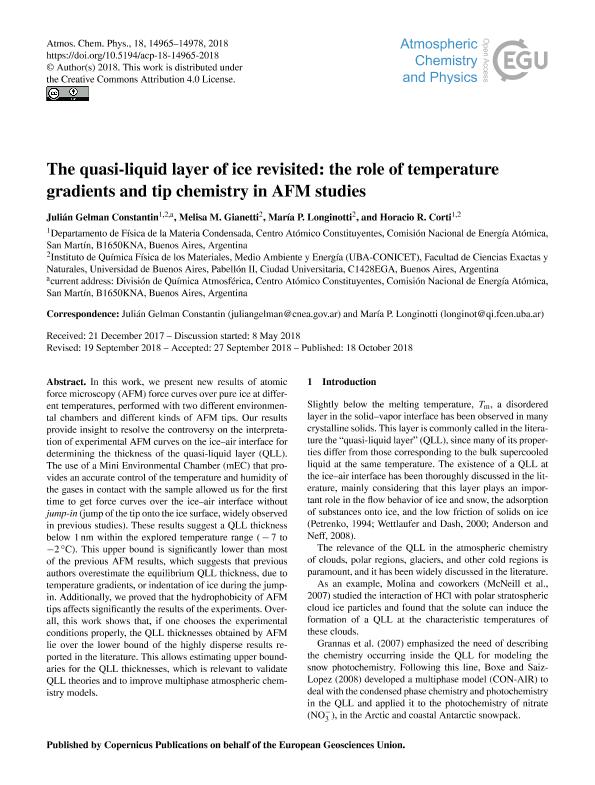Artículo
The Quasi-Liquid Layer of ice revisited: the role of temperature gradients and tip chemistry in AFM studies
Gelman Constantin, Julián ; Gianetti, Melisa Mariel
; Gianetti, Melisa Mariel ; Longinotti, María Paula
; Longinotti, María Paula ; Corti, Horacio Roberto
; Corti, Horacio Roberto
 ; Gianetti, Melisa Mariel
; Gianetti, Melisa Mariel ; Longinotti, María Paula
; Longinotti, María Paula ; Corti, Horacio Roberto
; Corti, Horacio Roberto
Fecha de publicación:
10/2018
Editorial:
Copernicus Publications
Revista:
Atmospheric Chemistry and Physics Discussions
ISSN:
1680-7375
Idioma:
Inglés
Tipo de recurso:
Artículo publicado
Clasificación temática:
Resumen
In this work, we present new results of atomic force microscopy (AFM) force curves over pure ice at different temperatures, performed with two different environmental chambers and different kinds of AFM tips. Our results provide insight to resolve the controversy on the interpretation of experimental AFM curves on the ice–air interface for determining the thickness of the quasi-liquid layer (QLL). The use of a Mini Environmental Chamber (mEC) that provides an accurate control of the temperature and humidity of the gases in contact with the sample allowed us for the first time to get force curves over the ice–air interface without jump-in (jump of the tip onto the ice surface, widely observed in previous studies). These results suggest a QLL thickness below 1 nm within the explored temperature range (−7 to −2 ∘C). This upper bound is significantly lower than most of the previous AFM results, which suggests that previous authors overestimate the equilibrium QLL thickness, due to temperature gradients, or indentation of ice during the jump-in. Additionally, we proved that the hydrophobicity of AFM tips affects significantly the results of the experiments. Overall, this work shows that, if one chooses the experimental conditions properly, the QLL thicknesses obtained by AFM lie over the lower bound of the highly disperse results reported in the literature. This allows estimating upper boundaries for the QLL thicknesses, which is relevant to validate QLL theories and to improve multiphase atmospheric chemistry models.
Palabras clave:
QUASI-LIQUID LAYER
,
ICE
,
ATOMIC FORCE MICROSCOPY
,
FORCE CURVES
Archivos asociados
Licencia
Identificadores
Colecciones
Articulos(INQUIMAE)
Articulos de INST.D/QUIM FIS D/L MATERIALES MEDIOAMB Y ENERGIA
Articulos de INST.D/QUIM FIS D/L MATERIALES MEDIOAMB Y ENERGIA
Articulos(INTEMA)
Articulos de INST.DE INV.EN CIENCIA Y TECNOL.MATERIALES (I)
Articulos de INST.DE INV.EN CIENCIA Y TECNOL.MATERIALES (I)
Articulos(SEDE CENTRAL)
Articulos de SEDE CENTRAL
Articulos de SEDE CENTRAL
Citación
Gelman Constantin, Julián; Gianetti, Melisa Mariel; Longinotti, María Paula; Corti, Horacio Roberto; The Quasi-Liquid Layer of ice revisited: the role of temperature gradients and tip chemistry in AFM studies; Copernicus Publications; Atmospheric Chemistry and Physics Discussions; 18; 20; 10-2018; 14965-14978
Compartir
Altmétricas



